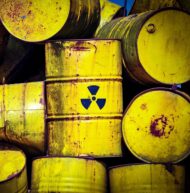Nuclear fusion: not the answer to our energy needs
The nuclear fusion process is costly, dangerous and unnecessary, and CND opposes the proposed imposition of these reactors on local communities.
What is nuclear fusion?
Conventional nuclear reactors are based on fission: they split uranium or plutonium atoms and use the heat produced. Fusion reactors however, do the opposite and fuse together deuterium and tritium atoms (isotopes of hydrogen) at extremely high temperatures and pressures into larger helium atoms. The mass of the helium atom is a tiny bit less than the combined masses of the deuterium and tritium atoms and this mass is converted to energy which is therefore an output from the fusion process. It is the same process that goes on inside the Sun – and in hydrogen bombs. At high temperature and densities these gases are ionised (stripped of their electrons) and form a hot, dense, plasma that has to be constrained by strong magnetic fields and laser-based confinement systems. The whole process is technically extremely difficult and the magnets, pumps and other equipment consume considerable amounts of energy.
For over 70 years, national and international experiments have attempted to achieve both a sustained reaction and a reaction that generates more power than it consumes. A supposed ‘breakthrough’ in December 2022 has been questioned by experts. The UK-based JET laboratory announced it had demonstrated the greatest amount of energy output from any fusion process in history. But it is still believed to be decades before the technology would be commercially viable.
The multi-billion-euro, international fusion project ‘International Thermonuclear Experimental Reactor’ (ITER) in France aims to demonstrate that fusion actually works on a large scale. Construction started in 2010 and the first experiments could begin in 2025. However, all fusion projects have notorious records for being behind schedule.
The fuels – deuterium (H-2) and tritium (H-3)
Deuterium gas can be extracted from ordinary water and is readily available, albeit at considerable expense. However, tritium gas, which is very radioactive, is extremely rare and at present needs to be obtained from US reactors (currently Watts Bar in Tennessee US) at massive cost. The tritium supplies from this US nuclear station (currently not operational) are already fully earmarked for topping up US and UK nuclear weapons. It is not known where the very large amounts of tritium needed for any mooted UK fusion plant would be sourced from.
The promises
Fusion reactors come with the usual promises of high-tech investment, jobs, and cheap and clean energy to help move to a zero-carbon economy with little radioactive waste and no plutonium by-products for nuclear weapons. But how valid are these claims?
The problems
The reality is that fusion reactors, if ever operated, would produce by-products that are far from harmless. In addition, most (around 80%) of the output energy would be in the form of high-energy neutrons which would lead to structural damage, large amounts of radioactive waste and the need for much biological shielding to protect operators and the public nearby.
Fusion plants can best be viewed as gigantic exercises in tritium recycling, and, if a plant was ever constructed, large amounts of radioactive tritium would be released into the atmosphere and via the cooling water. This would contaminate all areas downwind and downstream. Some nuclear scientists think that tritium is a ‘weak’ nuclide but the reality is the opposite. If an explosion and/or fire occurred (tritium and deuterium are both flammable), the amounts of radioactivity released would be even greater and would constitute a nuclear disaster.
Fusion reactors would also be subject to the major problems associated with fission reactors, including large-scale cooling demands, and high construction and operational costs. The structure, damaged by neutron bombardment, would need to be replaced periodically, resulting in large amounts of radioactive wastes for which there is no current solution in the UK.
What do the experts say?
In the past, many scientists have opposed nuclear fusion. More recently, Dr Daniel Jassby (a research physicist at the Princeton Plasma Physics Lab until 1999) worked for 25 years in areas of plasma physics and neutron production related to fusion energy research and development. He has written informative articles on the myriad problems with nuclear fusion and concludes: “When you consider we get solar and wind energy for free, to rely on fusion reaction would be foolish.”
Despite industry statements that fusion reactors do not produce plutonium as a by-product, the streams of neutrons produced by the fusion process can be used to produce plutonium that could be used for nuclear weapons.
In short, nuclear fusion would not provide cheap, clean, safe or healthy energy but it would have strong links with materials necessary for nuclear weapons.
UK developments
The government has selected the West Burton A plant in Nottinghamshire as the site for the country’s first commercial nuclear fusion reactor.
The government has pledged more than £220 million for the project, described as a Spherical Tokamak for Energy Production (STEP), based on the unsuccessful Tokamak prototype at Culham in Oxfordshire. Quite why the STEP project is expected to work when its prototype failed is unexplained in official documents. It is perhaps best considered as another example of technological nuclear hubris.
The West Burton A plant should be operational by the early 2040s.
Conclusion
CND will support those campaigning against proposals to introduce nuclear fusion reactors in their communities and can supply speakers and education materials on the dangers of fusion on request. This is another dangerous diversion from producing clean energy and should be opposed.
